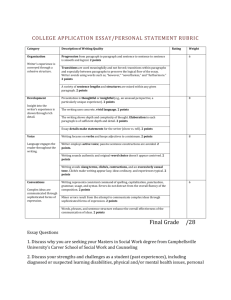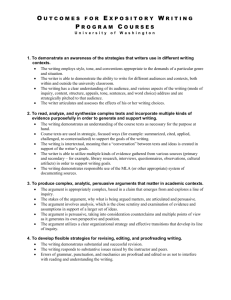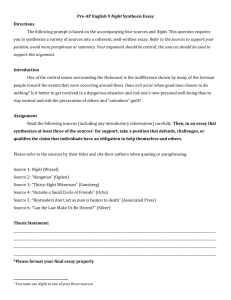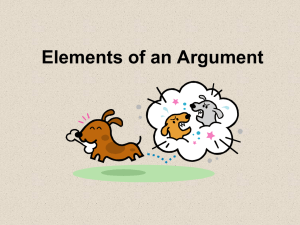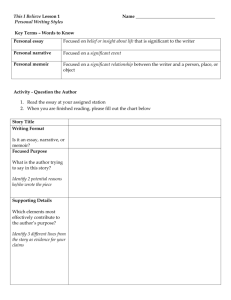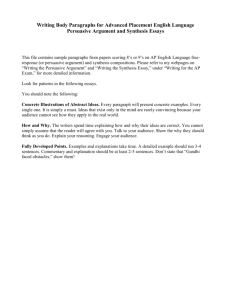The Bare Bones
advertisement
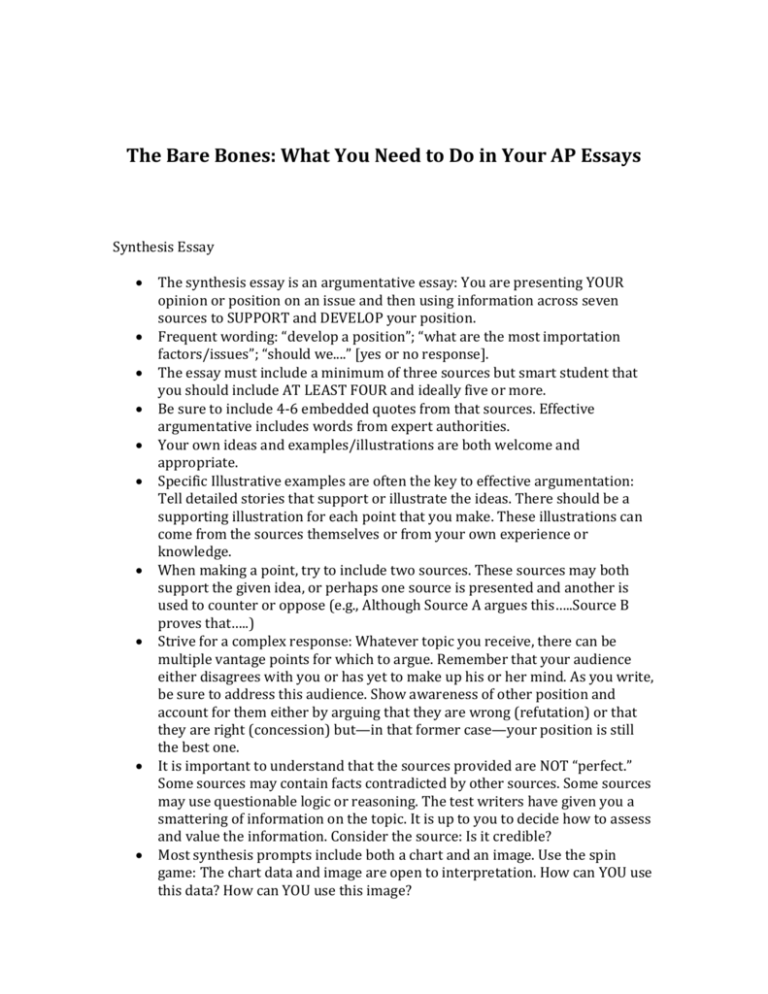
The Bare Bones: What You Need to Do in Your AP Essays Synthesis Essay The synthesis essay is an argumentative essay: You are presenting YOUR opinion or position on an issue and then using information across seven sources to SUPPORT and DEVELOP your position. Frequent wording: “develop a position”; “what are the most importation factors/issues”; “should we....” [yes or no response]. The essay must include a minimum of three sources but smart student that you should include AT LEAST FOUR and ideally five or more. Be sure to include 4-6 embedded quotes from that sources. Effective argumentative includes words from expert authorities. Your own ideas and examples/illustrations are both welcome and appropriate. Specific Illustrative examples are often the key to effective argumentation: Tell detailed stories that support or illustrate the ideas. There should be a supporting illustration for each point that you make. These illustrations can come from the sources themselves or from your own experience or knowledge. When making a point, try to include two sources. These sources may both support the given idea, or perhaps one source is presented and another is used to counter or oppose (e.g., Although Source A argues this…..Source B proves that…..) Strive for a complex response: Whatever topic you receive, there can be multiple vantage points for which to argue. Remember that your audience either disagrees with you or has yet to make up his or her mind. As you write, be sure to address this audience. Show awareness of other position and account for them either by arguing that they are wrong (refutation) or that they are right (concession) but—in that former case—your position is still the best one. It is important to understand that the sources provided are NOT “perfect.” Some sources may contain facts contradicted by other sources. Some sources may use questionable logic or reasoning. The test writers have given you a smattering of information on the topic. It is up to you to decide how to assess and value the information. Consider the source: Is it credible? Most synthesis prompts include both a chart and an image. Use the spin game: The chart data and image are open to interpretation. How can YOU use this data? How can YOU use this image? You’ve Got Personality! –Be interesting when you write. Make jokes. Add drama. Be sarcastic (if you wish). Basically: Don’t be dull. Writing with personality adds interest and intrigue. If the audience is paying attention, then you are more likely to be effective. Introduction: Why not begin with a story (illustration) that introduces the topic or issue and naturally leads to your opinion? Conclusion: End by WINNING. You want your final sentence to hang in the air in such a manner that your reader is nodding his or her head, saying, “Yes! YES! YEEEEESSSSSS! You are absolutely right, Master.” Persuasive Argument The persuasive argument is a synthesis essay without sources. The difference? All ideas, facts, examples, and illustrations must come from YOU. You will receive an issue that can be argued from multiple vantage points. There are no correct answers—only effective arguments. Writing is a Strategic Process: Your audience is a person who either doesn’t agree with you or has yet to make up his or her mind. What can you say to them that will get them to support your own opinion? DEPTH OF THOUGHT is the number one scoring criteria. Your paper must present a reasonable position supported by rational argument. Thus, be sure to spend time thinking about the issue. Avoid simplicity: A simple paper might give only two examples as to why your position is right. But—can’t everyone find examples to support whatever opinion they have? Avoid writing papers that only consist of examples supporting your opinion. Address the Opposition: In order to reach those who think differently from yourself, you must address their concerns in some manner or form, either through refutation or concession. Remember: Sometimes the opposition is right—but that doesn’t mean we should do as they suggest. Related to the above: Writing is a strategic process. Ask yourself: What can I show my readers that will convince them—absolutely—that my position is right? (Don’t write about the first things that come to mind—think about what would work best. How will others consider what you say?) Qualify! To qualify is to acknowledge that your position is imperfect but— nonetheless—is still the best approach. Brainstorm prior to writing. Focus on the terms to be used. If you are asked to write about entertainment, then consider what entertainment is. If you are asked to write about luxuries, then ask what a luxury is. Etc. When writing, the terminology used in the argument must have a clear definition. Brainstorm prior to writing: Consider both sides of the argument. Perhaps you have an instant opinion—but still spend time considering the opposing view. To persuade your audience, you need to consider the matter in the way that others might. You think this—but they think that. Why do they think that? What can you show or explain to them that will change their minds? Specific Illustrative Examples are the key to the persuasive argument. Tell stories that—without question—show that your position is both reasonable and correct. Examples may come from history, personal experience, current events, politics, film, literature—anywhere! WRITE ABOUT WHAT YOU KNOW. You will always write more effectively when you are familiar with what you write about. Introduction: Why not begin with a story that both introduces the topic and leads to your opinion? Conclusion: End by WINNING. You want your final sentence to hang in the air in such a manner that your reader is nodding his or her head, saying, “Yes! YES! YEEEEESSSSSS! You are absolutely right, Master.” Rhetorical Analysis Introduction: Establish the rhetorical triangle. Who is the speaker? Who is his or her audience? What is the purpose of the speech/essay? Generally speaking, how is the writer trying to sway his or her audience? Organization: Follow the Argument! Effective arguments follow a logical order. There is a reason this is done first, and something is done next. Your paper should simply follow the argument, with each body paragraph address a key choice. After explaining the significance of the choice, indicate what the writer does next—and why. The Basic Paragraph: Identify a choice the writer makes. Follow by quoting direct evidence. End by answering these important questions: WHY did the writer make this choice? HOW does this choice work to move the audience towards thinking or acting in the manner that the writer wants? (The more time answering/explaining the WHY and HOW questions, the higher your grade!) A good strategy: Sometimes a writer presents a series of examples in support of one idea. Briefly quote these examples and link them together when making your point. Example: In the second and third paragraphs, Don Juan presents a series of economic consequences (“lower wages”; “reduced savings”; “higher taxes”) to frighten his audience, turning them against….” IDENTIFYING CONNECTIONS OR PATTERNS ACROSS THE TEXT is characteristic of high-scoring papers. Conclusion: End by analyzing the writer’s final paragraph. No summative conclusions! As you analyzing the writer’s final paragraph, explain how all of the author’s choices build to these final words, which are intended to hang in the audience’s mind saying, “Yes! YES! YEEESSSS! You are right!” Do NOT offer your own opinion—this prompt is pure analysis. (Caveat: Twice in twenty five years students have been asked to analyze and then offer their own evaluation as to whether the argument would be successful. Do read the prompt—if you opinion is asked for, then make it so. BUT—this has not happened in 10+ years. For Further Study: Go to AP Central and find the released AP test prompts on the AP English Language Exam information pages. (They have all prompts since 1999, including graded sample essays with commentary.) Read over all the prompts from 2007 to the present. Consider how you would respond; then, go read the sample essays. Consider the scorers commentary. Analyze the differences between essays scoring 7, 8, or 9 and those scoring 5 or 6. If you can see the difference, then you should know what you need to do. The best way to learn how to write is to look at effective writing and to recognize effective choices.




